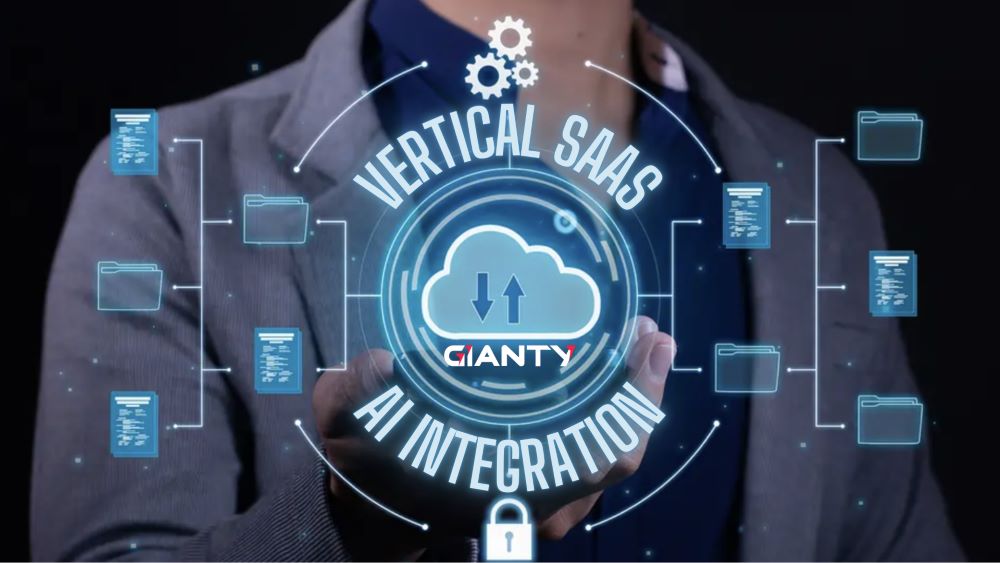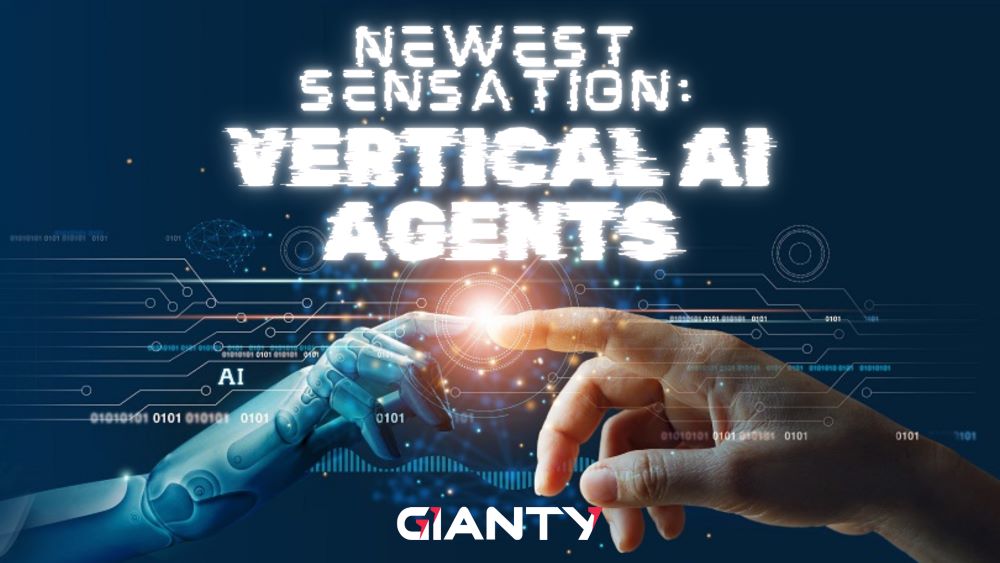Integrating temporary external professionals is a highly flexible and widely used strategic solution for businesses seeking to expand their capabilities or provide their in-house team with assistance, effectively covering a range of problem areas while remaining in control.
Seeing how rapidly the tech industry is expanding, the demand for highly skilled IT personnel has also risen accordingly. IT staff augmentation services are one of the many ways to gain access to these specialists on a global scale.
With more and more companies turning to staff augmentation over the years, it is predicted that about $81.87 Billion will be invested into the staff augmentation market by 2025.
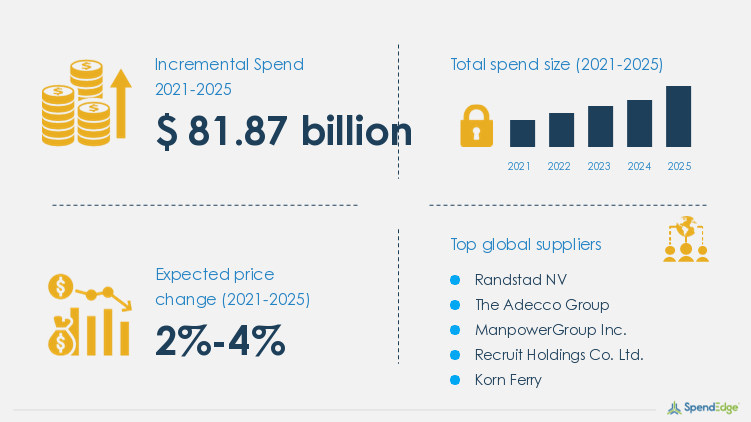
This blog will help you figure out:
- When to consider IT staff augmentation
- The different types of staff augmentation
- How to implement IT staff augmentation
- The benefits and challenges of IT staff augmentation
- The best practices for a successful IT staff augmentation
When to Consider IT Staff Augmentation
It is crucial to remember that you need to make sure if IT staff augmentation services are even needed in the first place because, while undeniably useful, they are not suited as a solution for every scenario. Staff augmentation could help you with these:
1. Exploring New Markets
- Hiring local expertise with language, culture, and legal knowledge will give you an accurate insight into a foreign market, helping you to create a strategy accordingly
- Having workers from all around the world makes it possible to constantly work on the product as well as to always be available to customers
2. Acquiring New Skill Sets
- Finding specialized staff in niche areas to fill in gaps within the team or simply enhance the team
- Getting an outside perspective to approach a project from another angle
- Adding a few extra specialists to help work on a project, delivering the final product within less time than it would usually take with the in-house team alone
3. Adding to the in-house team
- Distributing increased workload amongst more people so that the in-house team members aren’t overwhelmed by the amount
- Covering for shortages, absences and staff on leave
- Helping with previous blockages and sharing knowledge
Types of Staff Augmentation
Over time, many various types of staff augmentation have been developed to fit everyone’s needs, making it a very versatile practice.
It is important to remember that different projects have different, unique needs. That is why you should choose wisely on which type is the right one, based on the kind of project you’re working on.
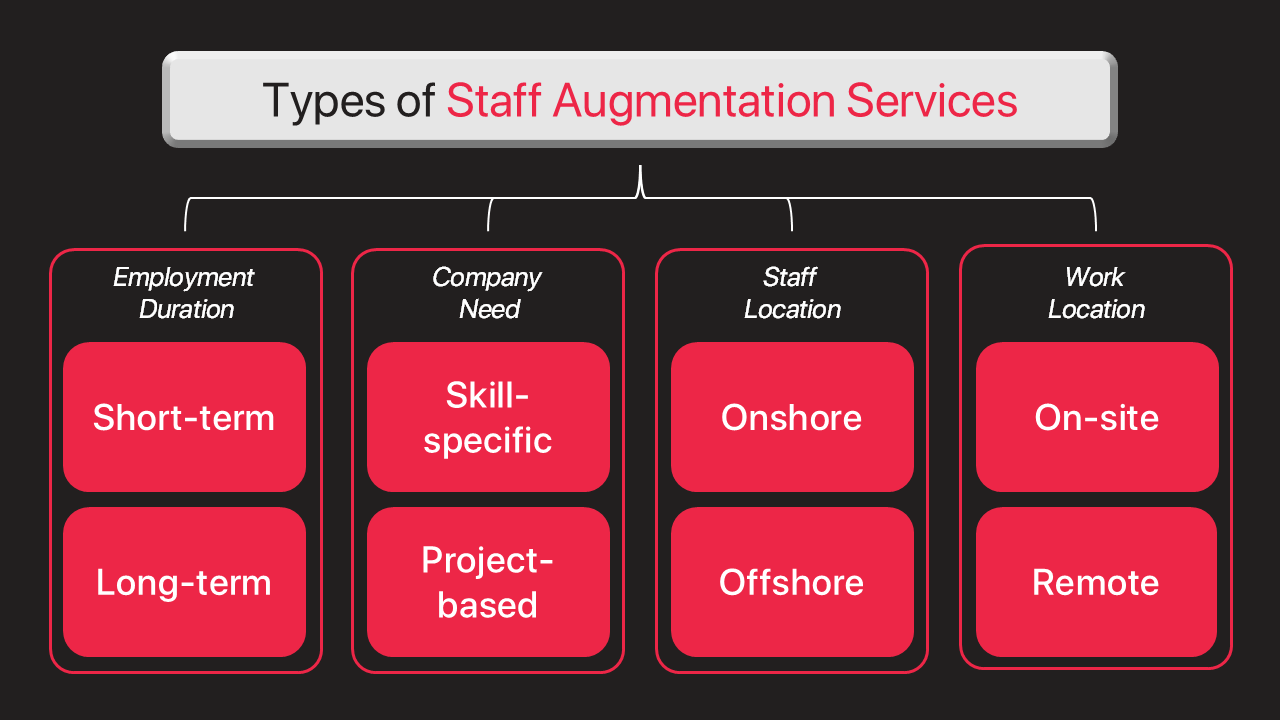
1. Employment Duration
- Short-term augmentation: External staff is hired for a brief period of a few weeks to a few months, addressing the company’s immediate, pressing needs that do not require constant, on-going support. Used to lend support for the in-house team during time-sensitive projects, cover staff absences or manage increased demand.
- Long-term augmentation: This type of staff augmentation allows companies to keep external professionals for an extended time (usually more than six months). It is more suitable for larger, continuous projects and ongoing skill shortages, maintaining flexibility while building a stable team of specialized talent without the long-term commitments associated with traditional hiring.
2. Company Need
- Skill-specific augmentation: This approach enables businesses to quickly acquire specialized skills that may be lacking in their current team by bringing in external help with targeted expertise. By leveraging skill-specific augmentation, companies can enhance their operational efficiency and innovation, ensuring that they have the right talent in place to tackle complex tasks while maintaining flexibility and cost-effectiveness in their staffing strategies.
- Project-based augmentation: External sources get brought in for a defined duration to support specific projects or initiatives within an organization. As soon as the project is finished, they are released. This approach allows companies to quickly ramp up resources, enabling them to meet tight deadlines or scale operations as needed.
3. Staff Location
- Onshore augmentation: This location-based requirement limits the pool of potential staff only to people that reside in the same geographic location as the in-house team. This ensures that all employees operate within the same time zone, share the same work ethnic and speak the same language, simplifying both communication and close coordination.
- Offshore augmentation: Offshore staff augmentation allows businesses to access a diverse talent pool and specialized skills from all around the world that may not be available locally, often leading to significant cost savings. The difference in time zones could be turned into an advantage, by providing the opportunity that the project can be worked on at all times.
4. Work Location
- On-site staff augmentation: This approach facilitates direct collaboration and communication by bringing external professionals into a company’s physical location to work alongside existing teams, allowing augmented staff to integrate seamlessly into daily operations and align closely with company culture and goals. This model is particularly advantageous for projects that require hands-on involvement or close coordination with internal staff.
- Remote staff augmentation: External staff can work from different locations to complete their tasks. This allows businesses to access a broader talent pool without geological limitations, enabling them to bring in specialized skills and expertise as needed. While remote augmentation can mitigate some of the challenges of offshore arrangements it still requires effective communication and collaboration to ensure seamless integration with the existing team.
How to Implement IT Staff Augmentation
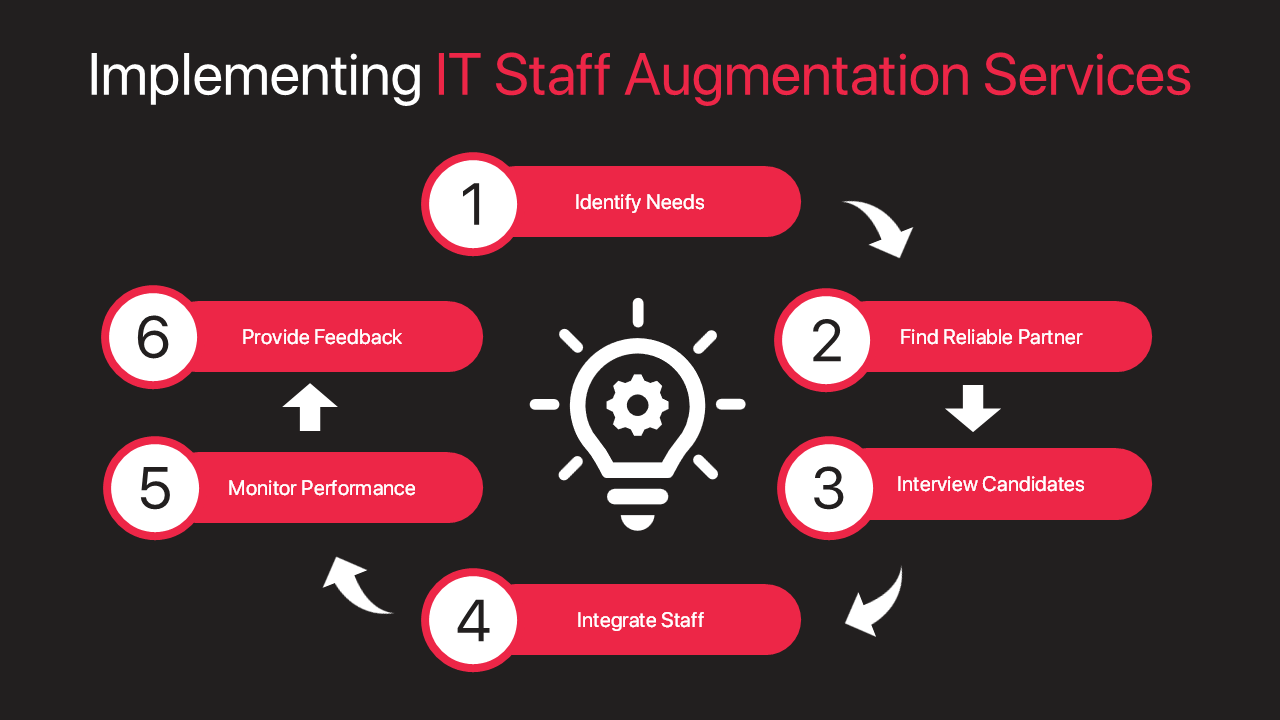
- Identify your needs: Assess the current team’s capabilities and determine specific skill gaps and the project’s objective, duration and requirements
- Select a reliable partner: Research and choose a respectable agency or service provider with a positive track record on IT staff augmentation
- Interview possible candidates: Conduct interviews and assessments to evaluate the candidate’s qualifications and compatibility with your team
- Integrate augmented staff: Foster collaboration between the external professionals and the existing employees to promote teamwork, communication and collaboration
- Monitor performance: Track the performance and productivity throughout the duration of the project
- Provide feedback: Communicate regularly with the augmented staff to get an oversight on their work and address any challenges that may arise
Benefits of IT Staff Augmentation
Flexibility and Scalability
Companies can rapidly adjust their workforce by bringing in external specialists for critical projects and business objectives, ensuring they have the necessary skills to meet deadlines as well as deliver high-quality results.
This allows for a swift response to fluctuating market changes and demands.
Access to Specialized Skills
A major advantage of staff augmentation which allows companies to tap into a diverse talent pool that may not be available at the moment.
By hiring external IT staff who possess specific expertise in areas such as cybersecurity, data analysis or emerging technologies, companies can enhance their project capabilities and fill immediate skill gaps.
Cost-effectiveness
By augmenting professionals, companies can lift up to 70% of the financial burden that comes with hiring professional hires.
Through leveraged external tech talent, companies are able to avoid costs such as benefits and extended training. These spared resources can now be allocated more strategically like for investments or technologies.
Reduced Hiring Risks
Through staff augmentation companies can now bring in professionals on a temporary basis without committing to long-term employment contracts which minimizes the financial and operational risks that come with permanent hires, such as high turnover rates.
Faster Market Time
By swiftly integrating specialized personnel who can contribute immediately, companies can maintain momentum, streamline workflows, and ultimately deliver high-quality results on time, enhancing overall productivity and client satisfaction.
Even organizations like the Internal Revenue Service (IRS) have successfully integrated IT staff augmentation services to bring in experts for additional support and meeting tight deadlines.
IT Staff Augmentation Challenges
Language Barriers and Cultural Differences
Hiring staff from around the world with various backgrounds can lead to misunderstandings and miscommunication between teams due to differences in language, communication style, work ethics, and decision-making processes.
Nuances may be lost, resulting in inefficiencies and errors. This barrier can also hinder cooperation and rapport-building, making integration into existing teams difficult for augmented staff.
This challenge underscores the importance of effective communication strategies and cultural awareness to ensure that augmented staff can contribute effectively to project goals.
Communication is the primary responsibility for those in GIANTYs controller team. They make sure all parties involved understand each other clearly by building and maintaining relationships with our clients, using their knowledge of the company and industry to ensure a smooth and successful collaboration.
Cost Considerations
While staff augmentation can provide access to specialized skills and flexibility, hidden costs such as onboarding and potential inefficiencies can quickly escalate the budget far beyond what the company can afford.
Careful planning and transparent communication about costs are essential to ensure that the desired results are delivered. Depending on the level of experience prices can range from a monthly rate of $3.000 up to $15.000.
Dependency on Augmented Services
Organizations may become reliant on external talent for critical functions, rendering themselves vulnerable if augmented staff leaves or if the project requirements shift unexpectedly.
The lack of internal knowledge transfer can hinder the maintenance of continuity and the overdependence may stifle the development of the in-house team, making future challenges difficult to respond to.
To mitigate these risks, it is essential to establish strong knowledge-sharing practices and ensure that internal teams remain engaged in key processes.
Increased Security Risks
Bringing in external personnel can expose organizations to potential vulnerabilities as the risk of data breaches or compliance violations increases through their access to sensitive information.
For that, cohesive security measures must be implemented. At GIANTY, all new hires are required to undergo a detailed security brief, to name one example.
By successfully implementing the Information Security Management System according to ISO/IEC 27001:2022 standard, GIANTY has been awarded with the ISO 27001 certification, proving our commitment to security of the information and data of our clients and partners.
Best Practices for Successful IT Staff Augmentation
Integrating Augmented Staff With Team
Success often hinges on an effective integration of augmented staff with the internal team as a collaborative environment ensures seamless teamwork and an exchange of knowledge.
By actively involving the external personnel throughout the duration of their time within the company a sense of belonging can be created which brings out the full potential of their diverse set of skills.
A successful integration makes itself known in the form of enhanced productivity, boosted team morale and fruitful results.
Monitoring Performance and Outcomes
Regular check-ins and feedback create opportunities to address challenges and celebrate achievements, ensuring that augmented staff remains aligned with project goals.
By analyzing outcomes throughout the engagement, organizations can make informed adjustments, optimizing both individual contributions and overall team efforts.
Communication Between Teams
Effective communication is the key to bridge any gaps between augmented staff and existing teams. Clear communication and transparency ensures for everyone to be on the same page regarding the company’s goals, responsibilities, and expectations.
In regular meetings team members can share insights and address challenges, which improves overall productivity and project outcomes by empowering the external specialists to wholeheartedly contribute with their expertise.
Adapting and Scaling if Needed
As projects go on, companies must remain vigilant, reassessing team needs and resource allocation regularly, which not only involves scaling up with additional tech talent or expertise but also recognising when to downsize or adjust roles to optimize efficiency.
This ensures that specific skills are in the right place at the right time, helping the navigation of challenges and changing priorities and demands.
GIANTY as Your Partner
GIANTY is offering their very own IT staff augmentation services as well. With more than 20 years of experience in the industry, we have had the opportunity of working with a variety of clients, continuously supporting them with our IT expertise in areas such as software, game, AI, and mobile development.
With GIANTY taking care of the back office duties, our clients are able to focus their whole dedication to their projects, leaving the recruitment to us. After multiple rounds of interviews to assess each candidate’s individual skills and their ability to contribute to the project, fast results and immediate service are to be expected.
We strive to maintain our track record of being a reliable partner to our clients, with a highly dedicated team of professionals who will provide high-quality results that are tailored perfectly to our client’s vision.
Contact GIANTY if you’re interested in any of our services or if you would like to collaborate with us.




